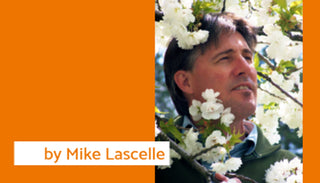Over the years, as both a landscaper and nursery manager, I have planted and sold hundreds of David Austin roses. In all that time I was rarely disappointed, as David Austin is a breeder with impeccable credentials and a stellar reputation that it guards closely. But with climate change, some varieties are exhibiting less resistance to pests and diseases, so David Austin has reacted by cutting up to 30% of their cultivars, including much-loved varieties such as ‘Munstead Wood’, ‘Abraham Darby’, ‘Sweet Juliet’, ‘William Shakespeare’, and ‘Graham Thomas’. While I still get many requests for these discontinued roses, I thought I would highlight lesser-known next-generation English rose cultivars that we currently stock, which have been bred to perform well into the future.
Rosa ‘Gabriel Oak’ (AUScrowd 2019)
‘Gabriel Oak’ is a repeat-flowering cultivar that bears abundant rich pink rosette-style blooms which are paler towards the edges. It emanates a strong fruit fragrance and has a vigorous growth habit with the flowers held on purple-tinted stems. Grows 4’ tall and wide.
Rosa ‘The Poet’s Wife’ (AUSwhirl 2014)
'The Poet's Wife' is a choice variety with bright yellow flowers that fade to primrose, bearing a rich lemon fragrance that gets stronger and sweeter with age. This rounded rose shrub will grow 4’ tall and wide with attractive glossy green foliage. Repeat blooms throughout the season.
Rosa ‘Roald Dahl’ (AUSowlish 2016)
'Roald Dahl' is another repeat-blooming cultivar with reddish-orange buds that open to cupped rosettes of a delicate apricot hue. Expect a distinct fruity tea scent and a rounded shrub with good disease resistance and few thorns, maturing at 3’ tall. The name of this rose was meant to celebrate his most famous work, James and the Giant Peach.
Rosa ‘Tranquility’ (AUSnoble 2012)
‘Tranquility’ bears perfect, rounded rosettes of pure white tinged with yellow or pale pink in bud. These roses have a light fruit fragrance and are borne on vigorous shrubs (growing just over 4’ tall) clothed in light green foliage. Repeat-flowering.
Rosa ‘Eustacia Vye’ (AUSegdon 2019)
Rosa ‘Eustacia Vye’, also known as ‘Sts. Francis and Claire’, is a variety that produces shallow cups of pastel apricot-pink that pale and form rosettes as they age. The blooms are held on red stems and are imbued with a strong fruity fragrance. ‘Eustacia Vye’ is a disease-resistant cultivar that grows to 4’ tall on average.
Rosa ‘Sir John Betjeman’ (AUSvivid 2008)
Although the fragrance is rather light on Rosa ‘Sir John Betjeman’, the abundant bright crimson-red rosettes are full-petaled and intensify in colour as they age. ‘Sir John Betjeman’ is a repeat-blooming variety with a slightly arching branch habit.
Rosa ‘Gentle Hermione’ (AUSrumba 2005)
Expect perfectly formed shallow cups of light pink with blush edges on Rosa 'Gentle Hermione'. These blooms emanate a heady myrrh fragrance and are borne throughout the growing season. The new foliage flush is tinted red on a shrub that grows slightly wider than tall (4’).
Rosa ‘James L Austin’ (AUSpike 2017)
Named after the son of David Austin Sr., Rosa ‘James L Austin’ is a repeat-blooming cultivar that bears large, deep pink rosettes accented with a button eye. The medium fruit fragrance only adds to its enticing beauty. This variety can be used to create an attractive flowering rose hedge.
Rosa ‘Imogen’ (AUStritch 2016)
The pale-yellow blooms of Rosa ‘Imogen’ fade to near cream, with frilled petals and a button eye. Expect a light fruit scent and a sturdy, upright shrub (to 3’ tall) that bears glossy green foliage. Rosa ‘Imogen’ tolerates partial shade.
Rosa ‘Princess Anne’ (AUSkitchen 2010)
The flowers on this repeat-blooming cultivar open pink-verging-on-red and fade to a pure rich pink. There is often a hint of yellow on the petal reverse and a lovely medium tea fragrance. The abundant blooms on Rosa ‘Princess Anne’ are held over thick, lustrous foliage.
Get an English Rose to Celebrate Pollinator Week
Last but not least is a reminder that June 19-25th is Pollinator Week here in Canada and roses are important sources of pollen for both domestic and wild bee species. Just one or two rose shrubs can make a big difference in supporting our local pollinators, and you still get to enjoy those beautiful, fragrant flowers.


